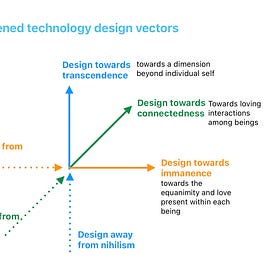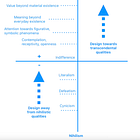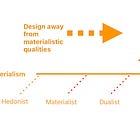This post started during a holiday in my native Finland, where I enjoyed reconnecting with relatives and friends, but also with a family summer cottage I hadn’t visited in 17 years. With my sister, I returned to the place of our childhood summers. Our stay was only for a night, but the return — I realised at some point in expectation for the visit — parallels a shift in my personal priorities. They’ve taken a turn from individualistic, career-focused, urban, nomadic enjoyment of global free movement, and towards places that represent home.
As I have recollected in previous posts, engaging with technology has represented home for me for the last 30+ years, albeit an intellectual one. But the power technologies have had; the power that swept me away decades ago, is losing its grip. And here I am, documenting that process of that detachment and trying to make sense of it in ways that I hope some of you find helpful regarding your situation and relationship to technology.
Over four recent posts, I mapped a proposal regarding what a spiritually informed, or an ‘awakened’ design space for technology development would look like. Today, I’ll summarise the rationale and introduce another layer onto it, inspired by the hope that such a design mindset would inspire fellow technologists to contribute to a more sustainable future.
Awakened technology design vectors: the overview
The four posts start with an introductory one where I introduce Professor Gabriel Fernandez-Borsot’s article that inspired the approach. He suggests that transcendence, immanence, and relationality represent three axes where interactions between technology and spirituality, and the corresponding world views and agency, occur.
What would an awakened approach to technology design look like?
[T]he cultivation of spirituality might be essential if we are to avoid a tech-fuelled pandemic of stress, dissociation, and domination. -Gabriel Fernandez-Borsot, Spirituality and technology: a threefold philosophical reflection (2023), p. 19.
I extend Fernandez-Borsot’s thinking with the coordinates — “the X, Y, and Z where technology and spirituality can meet” — and particular coordinates that define steps on the path, away from the negative space that has led us to the current ruins.
Together, the axes demarcate an aspirational design space, towards transcendental, immanent, and relational qualities, and away from a negative design space that reflects nihilist, cynical, individualistic, and materialist ones.
I propose that the axes enable us to respond to Fernandez-Borsot’s call for redefining what progress means in spiritually inspired contexts.
by pointing to the notion of progress, technological development forces spiritual traditions to define their own versions of progress while more explicitly delineating what it means to be a fully developed human, and what role contemplative development plays in this. -Gabriel Fernandez-Borsot (2023), p. 19.
A technologically informed, yet spiritually aspirational notion of progress means disembarking from the largely held notion of progress as a linear, endless economic growth and advancement of technology that extracts materials from nature without constraints apart from physics. In so doing, technologies support rather than hold back the notion of growth.
But it does not have to be so. If technologies we use to drive the extraction and exploitation are “rehomed”, i.e. altogether retired or redesigned to serve purposes that acknowledge planetary limits and the connectedness of all beings, they begin to serve economical degrowth while cultivating spiritual growth.
The X, Y, and Z where technology and spirituality can meet
In the three following posts in the series, I looked at the individual axes and their particular coordinates:
There are undoubtedly inconsistencies in the model. I have yet to review and iterate, with more depth, how to take the approach into practice (if I would ever do a second PhD, that would be the undertaking).
Since posting the series about the awakened design approach, I have proposed another, quite pragmatic tool (embedded below) with which to ask similar questions of existing technologies — rather than the questions ones still under design and development can benefit from:
“Congratulations to whoever invents forests”
If I've walked into a lot of rooms, over the past fifteen years, and started off talking about climate change, we often ended up talking about something else: the question of what might be worth doing in a time of endings. What is the work that makes sense amon…
The approaches are meant to be complementary and very much under iteration and further development; writing about them here is part of the process.
The design space for rebuilding
Together, the two approaches outlined above aim to generate ideas about rehoming technologies and rebuilding them. The space that the positive ends of the awakened axes demarcate yields a rich possibility space — a space to think about how technologies could enable people to express and enact selfless, somatic, and contemplative virtues, for example. This instead of the too often cynical, righteous, and materialist ends that various current technologies serve.
These questions go beyond technology, though. Any attempt at awakened design needs to acknowledge the multiple contexts where the design happens and gets distributed. For instance, while many medical and wellbeing technologies inherently embrace the positive space by their nature, by aiming to reduce pain and suffering, but regularly they get embedded into predominantly profit seeking business models. Our current communication technologies similarly hold the potential for relational qualities, but have suffered the same fate in the global marketplace. Such dynamics skew the technologies towards the negative space, regardless of what the intentions behind the original innovation were.
Case examples such as these are useful to remind us that technologies are never neutral; we who participate in building technology imbue values into the tools during the design and development processes. Therefore, as I have underlined in the above linked posts, the awakened approach is not about technology but about the mindset of technologists. It is about within which kinds of values technologists want to operate and subordinate themselves to.
It begins by rehoming yourself.
Thank you for reading.
With love and kindness,
Aki














Thank you David, I’m taking your feedback in good spirit! Also, you are spot on re the Cartesian aspect - definitely a blind spot I hadn’t recognised…I guess it tells about how indoctrinated one can remain to certain paradigms. Need to have a rethink about an alternative approach that would still be accessible.
Your substack is a gift to the world!